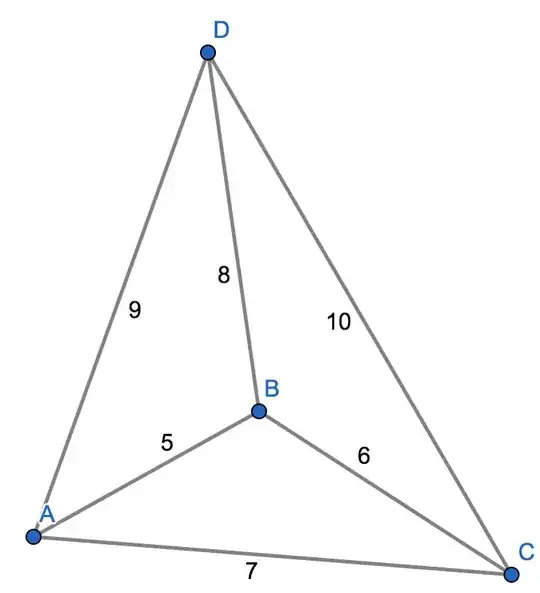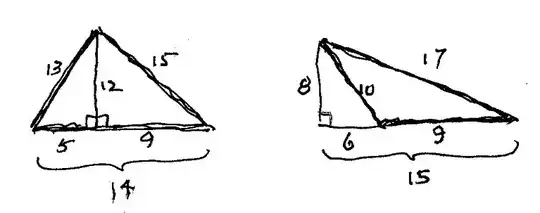This is possible only for acute triangles of a special type.
For example, a triangle with sides $a=10,\ b=17,\ c=21$ can be constructed as follows.
Let $n = 2$ and $c\in Ox.$ Then:
$$a = 2(2^{2n-2}+1) = 10,\quad a_x = 2(2^{2n-2}-1) = 6,\quad a_y= 2^{n+1}=8,$$
$$b = 2^{2n}+1 = 17,\quad b_x = 2^{2n}-1 = 15,\quad b_y = a_y=8,\quad c = a_x+b_x = 21,$$
wherein
$$\sin(\alpha)=\dfrac {a_y}{a} = \dfrac45,\quad \cos(\alpha)= \dfrac{a_x}{a} = \dfrac35,$$
$$\quad \sin(\beta) = \dfrac{b_y}{b} = \dfrac8{17},\quad \cos(\beta)=\dfrac{b_x}{b} = \dfrac{15}{17}.$$
The reason is that for any $n\geq 2,\quad k=0\dots n-1$ there are Pythagorean triples
with the sides $2^k(2^{2n-2k}\pm1)$ and with the common branch $2^{n+1}.$
More interesting examples can be constructed using known Pythagorean triples.
Some of them are given in the table below
$$\begin{vmatrix}
a & a_x & a_y=b_y & b & b_x & c= a_x+b_x\\
13 & 5 & 12 & 15 & 9 & 14\\
13 & 5 & 12 & 20 & 16 & 21\\
26 & 10 & 24 & 25 & 7 & 17\\
25 & 7 & 24 & 30 & 18 & 25\\
5 & \dfrac75 & \dfrac{24}5 & 6 & \dfrac{18}5 & 5\\
\end{vmatrix}$$
$$\color{brown}{\textbf{About triangle calculation}}.$$
Let $a=5,\ b=6,\ c=7,\ t=a_x,$ then
$$a^2-a_x^2 = b^2-b_x^2,$$
$$a^2-t^2 = b^2-(c-t)^2,$$
$$a_x=t=\dfrac{a^2-b^2+c^2}{2c} = \dfrac{19}7,\quad b_x= c-t = \dfrac{30}7,$$
$$a_y=b_y=\sqrt{a^2-a_x^2}=\sqrt{b^2-b_x^2}=\dfrac{12}7\sqrt6,$$
$$A=(0,0),\ B=(a_x, a_y) = \left(\dfrac{19}7,\dfrac{12}7\sqrt6\right),\ C=(0,c)=(0,7).$$

$$\color{brown}{\textbf{About triangular pyramid calculation (earlier question)}}.$$
Let
$$l_A=AD=9,\ l_B=BD=8,\ l_C=CD=10,\ x=D_x,\ y=D_y,\ h=D_z.$$
Then
$$l_A^2-(x^2+y^2) = l_B^2 - ((x-a_x)^2+(y-a_y)^2) = l_C^2 - ((c-x)^2+y^2)=h^2,$$
$$\begin{cases}
2a_xx+2a_yy = l_A^2 -l_B^2 + a^2\\[4pt]
2cx=l_A^2-l_C^2+c^2\\[4pt]
h=\sqrt{l_A^2-(x^2+y^2)}
\end{cases}\rightarrow
\begin{cases}
x=\dfrac{l_A^2-l_C^2+c^2}{2c} = \dfrac{15}7\\[4pt]
y = \dfrac{l_A^2 -l_B^2 + a^2 -2a_xx}{2a_y} = \dfrac{81-64+25-570/49}{\dfrac{24}7\sqrt6} = \dfrac{31}{21}\sqrt6\\[4pt]
h=\sqrt{l_A^2-x^2-\dfrac{\left(l_A^2 -l_B^2 + a^2 -2a_xx\right)^2}{4(a^2-a_x^2)}} = \color{brown}{\sqrt{\dfrac{190}{3}}}
\end{cases}$$
(see also Wolfram Alpha).
And trigonometry is not needed.

